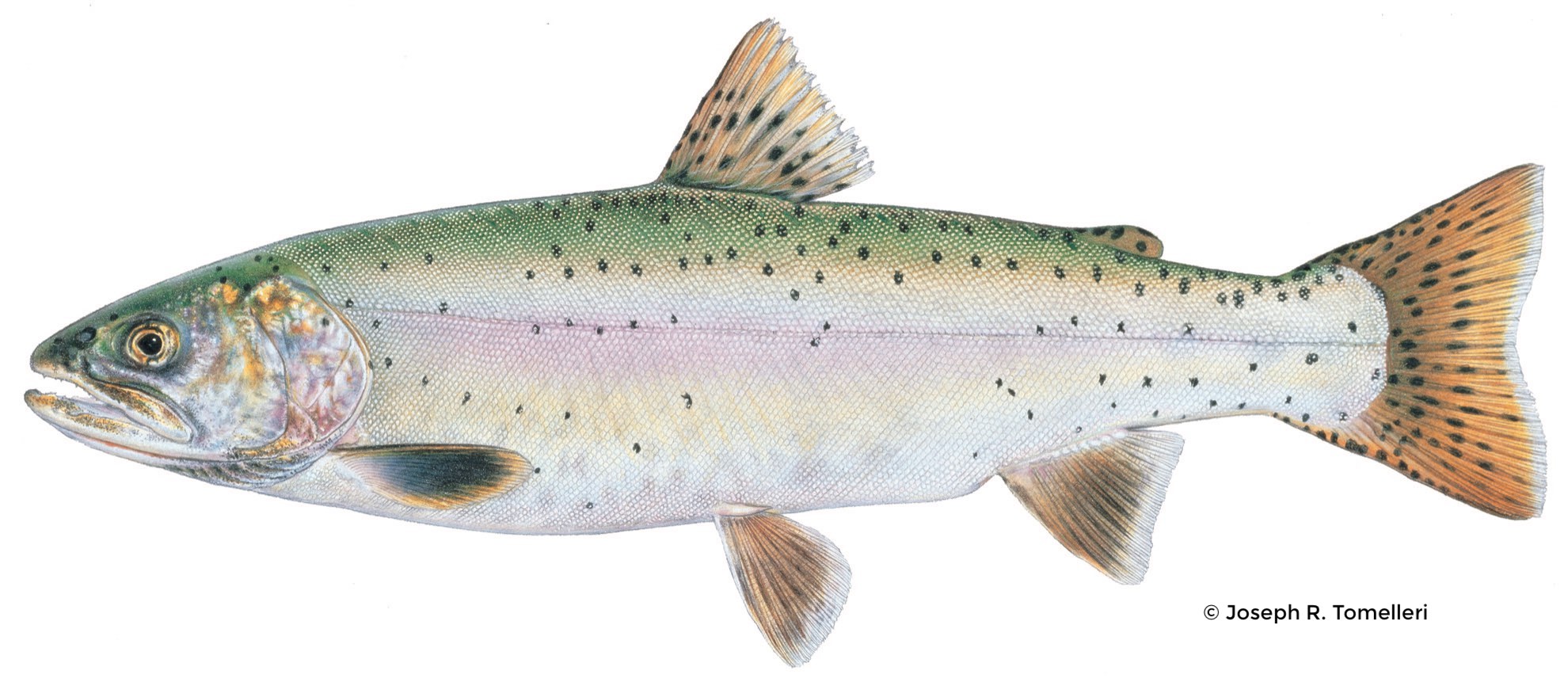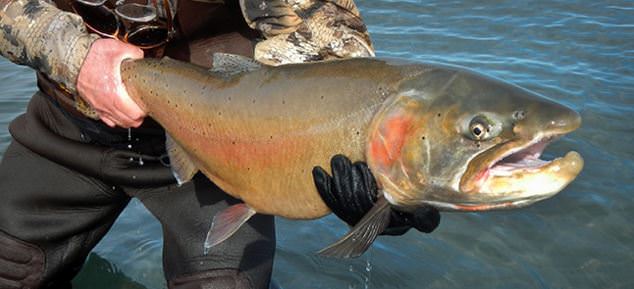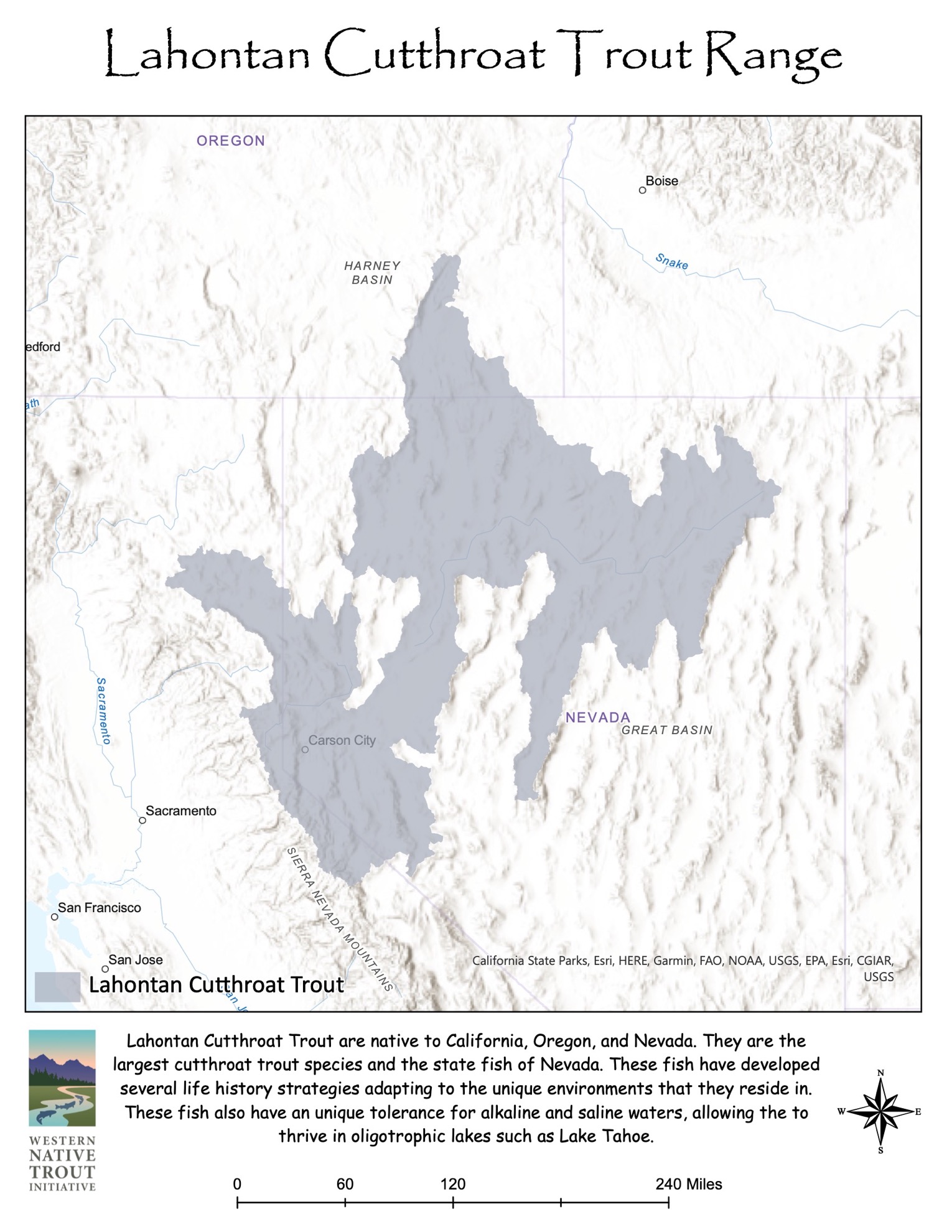
The Lahontan Cutthroat Trout is the largest cutthroat trout species and is the state fish of Nevada. The Lahontan Cutthroat Trout (LCT; Oncorhynchus clarkii henshawi) evolved in the hydrographically isolated Lahontan Basin of northeastern California, southeastern Oregon, and northern Nevada where ancient Lake Lahontan ebbed and flowed over millions of years. Recent work on the taxonomy of cutthroat trout supports recognizing several unique evolutionary forms comprising the LCT lineage (Peacock et al. 2018). These forms include the Western Lahontan Basin (Truckee, Carson, Walker rivers, including Summit Lake); the Northwestern Lahontan Basin (Quinn River); Eastern Lahontan Basin (Humboldt and Reese rivers); Coyote Lake Basin (Willow and Whitehorse rivers). There are two other forms in the LCT lineage—Paiute Cutthroat Trout from the East Carson River drainage, which has been listed as threatened, and LCT from the Alvord Lake Basin (Virgin-Thousand and Trout Creek drainages), where the native cutthroat trout form is extirpated. These LCT forms developed several life history strategies and traits adapting to the diversity of river, stream, and lake habitats with resident, migratory, adfluvial and lacustrine characteristics. Lacustrine forms of LCT are uniquely adapted to persist in the desert terminal lakes of the Lahontan Basin—they have an unusual tolerance for alkaline and saline waters. Some forms have adapted to thrive in oligotrophic alpine lakes (e.g., Lake Tahoe and Independence Lake).
 In 1800, it is believed that more than 370,000 surface acres of lakes (in 12 larger lake systems) and more than 7,400 miles of stream habitat was occupied or had the potential to be occupied by LCT (USFWS 2009). After the mid-1800s, immigration and settlement within the Lahontan Basin and Northern California resulted in impacts to LCT due to overharvest, mining, timber harvest, pollution, water diversions, dams and reservoirs, and introduction of non-native trout forms. By the mid-1900s, LCT were extirpated from a majority of larger drainage basins and generally restricted to isolated headwater, or small lake, systems. The LCT has been extirpated from more than 90 percent of historical habitat (Dunham et al. 1997; Dunham et al. 2003). Currently, LCT have been documented to occur throughout its historical range except in the Susan River drainage. About 70 self-sustaining LCT populations exist in about 10.5 percent of the historical habitat (752 stream miles and 1,394 surface acres). Less than 10 percent of stream populations remain, mostly in small, isolated, headwater habitat fragments with low levels of genetic diversity (Peacock et al. 2018). Significant portions of historical habitat are no longer suitable trout habitat due to climatic and anthropogenic factors. LCT currently occupy about 15 percent of the remaining potentially suitable habitat (LCT MOG 2019). There are also less than 30 out-of-basin LCT populations. . Dark olive backs and reddish to yellowish sides frequently characterize LCT found in streams, while the sides of lake-dwelling LCT are often silvery. The largest recorded LCT weighed in at 41 pounds.
In 1800, it is believed that more than 370,000 surface acres of lakes (in 12 larger lake systems) and more than 7,400 miles of stream habitat was occupied or had the potential to be occupied by LCT (USFWS 2009). After the mid-1800s, immigration and settlement within the Lahontan Basin and Northern California resulted in impacts to LCT due to overharvest, mining, timber harvest, pollution, water diversions, dams and reservoirs, and introduction of non-native trout forms. By the mid-1900s, LCT were extirpated from a majority of larger drainage basins and generally restricted to isolated headwater, or small lake, systems. The LCT has been extirpated from more than 90 percent of historical habitat (Dunham et al. 1997; Dunham et al. 2003). Currently, LCT have been documented to occur throughout its historical range except in the Susan River drainage. About 70 self-sustaining LCT populations exist in about 10.5 percent of the historical habitat (752 stream miles and 1,394 surface acres). Less than 10 percent of stream populations remain, mostly in small, isolated, headwater habitat fragments with low levels of genetic diversity (Peacock et al. 2018). Significant portions of historical habitat are no longer suitable trout habitat due to climatic and anthropogenic factors. LCT currently occupy about 15 percent of the remaining potentially suitable habitat (LCT MOG 2019). There are also less than 30 out-of-basin LCT populations. . Dark olive backs and reddish to yellowish sides frequently characterize LCT found in streams, while the sides of lake-dwelling LCT are often silvery. The largest recorded LCT weighed in at 41 pounds.
The Lahontan Cutthroat Trout was originally listed as endangered on October 13, 1970 under the Endangered Species Protection Act of 1969. On July 16, 1975, the Lahontan Cutthroat Trout was reclassified as threatened under the Endangered Species Act of 1973. There is no designated critical habitat for Lahontan Cutthroat Trout. The Recovery Plan for Lahontan Cutthroat Trout was approved on January 30, 1995. A status review in 2009 found that Lahontan Cutthroat Trout still meets the definition of threatened and no change in listing status was recommended. In 2019, the LCT Management Oversight Group (MOG) approved updated goals and objectives for the conservation of LCT (UGOs) that incorporate recent science, improved knowledge, and a widely accepted conservation framework to guide efforts in conjunction with the existing recovery plan. A status review in 2022 recommended no change in the listing status of Lahontan Cutthroat Trout. Although listed as threatened, Lahontan Cutthroat Trout can be harvested under a special 4(d) rule under the Endangered Species Act that allows the states to permit angling. Consequently, Lahontan cutthroats have played an important part of recreational fishing in Nevada, California and Oregon for the past 30 years. They are raised at State, Tribal and Federal Hatcheries both for recovery and recreational fishing purposes. In Nevada, numerous LCT waters are open to fishing and are very popular, including the Truckee River, Pyramid Lake, and Walker Lake populations. There are other numerous lakes and streams in the historic drainages that are stocked with LCT. In order to protect the integrity of fishable populations, special fishing restrictions are in place in some waters. The sports fish status of Lahontan Cutthroat Trout has improved angler support for reintroduction and conservation.
Between 2008 and 2018, the Western Native Trout Initiative has contributed over $222,500 to 8 projects benefitting Lahontan Cutthroat trout in Nevada and California. Project goals have been focused on fish migration barriers to protect Lahontan Cutthroat Trout populations on Maggie Creek, McDermitt Creek and Lower McDermitt Creek and on education and outreach efforts.

Additional Resources
- READ the 2022 Lahontan Cutthroat Trout Status Review from the U.S. Fish and Wildlife Service
- READ about a new tool helping biologists coordinate Lahontan Cutthroat Trout recovery efforts.
- READ the National Fish and Wildlife Foundation’s Lahontan Cutthroat Trout Keystone Initiative Business Plan.
- READ about Nevada Department of Wildlife’s efforts to conserve Lahontan Cutthroat Trout.
- READ about the Lahontan National Fish Hatchery Complex efforts to conserve Lahontan Cutthroat Trout.
- READ about California Department of Fish and Wildlife’s work conserving Lahontan Cutthroat Trout.
- READ about Oregon Department of Fish and Wildlife’s Lahontan Cutthroat Trout Conservation and Recovery Plans.
- READ about Pyramid Lake Fisheries of the Pyramid Lake Paiute Tribe.
- READ this feature article about Lahontan Cutthroat Trout Conservation from the U.S. Fish and Wildlife Service.
- READ about the Lahontan Cutthroat Trout’s status from the U.S. Fish and Wildlife Service.
Videos
WATCH this video about collaborative conservation efforts to benefit Lahontan Cutthroat Trout between the Lahontan National Fish Hatchery Complex and the Pyramid Lake Paiute Tribe.
WATCH Pilot Peak Lahontan Cutthroat Trout spawning in the lower Truckee River, courtesy of the U.S. Fish and Wildlife Service Lahontan National Fish Hatchery Complex.
